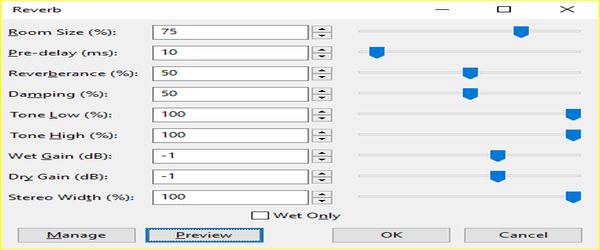Audio: reverberation (0:04)

reverberation plays a bubble sound effect created in three layers:
Reverberation, reverb for short, consists of multiple overlapping echoes with different delay times and amplitudes.
Reverb is a delay effect which simulates the behaviour of sound in an enclosed space. It reproduces the behaviour of sound waves when they reflect from surfaces.
The size and nature of the enclosed space are the two main factors that affect reverb. Size determines the delay time which in turn determines the spacing between echoes. The nature of the space determines the decay time which in turn determines how much amplitude is lost in an echo.
Delay time is a major factor in all delay effects including reverb. In reverb, each echo has a different delay time because there are so many paths that a sound can follow to arrive at a listener. The cumulative effect of multiple overlapping echoes is equivalent to comb filtering with a constantly varying delay time.
Decay time is the other main factor in reverb. Technically, decay time, or reverberation time as it is often called, is the time taken for the amplitude of an echo to reduce by 60dB, essentially to a level that is silent. The decay time takes into account two physical properties of sound which are that all surfaces absorb sound and that higher frequencies are absorbed more than low frequencies.
All surfaces absorb sound. Some surfaces absorb very little sound and will reflect an echo with only a small reduction in its amplitude. Stone and water are good sound reflectors. Other surfaces absorb most of the sound and considerably reduce the amplitude of any reflected echo. Carpets, soft fabrics and people are good sound absorbers.
High frequencies lose energy quicker than low frequencies. Repeat echoes sound boomier because they lose more of their high frequencies than their low frequencies when the sound is reflected. Essentially the reflecting surface acts as a low pass filter.
Hardware and software reverbs often include a daunting number of controls, each of which can be varied independently. Tweaking a reverb can involve hours of trial and error to get the right sound. To make matters worse, the terminology is not standardised and one reverb maker can label the same parameter differently to another. In addition, some reverbs may not include the same parameter as another. For example, a reverb may or may not include a predelay, a small delay of up to 10ms before the first reverb echo is heard.
Luckily, many reverbs include presets for different types of spaces. These automatically set the delay and decay times. A preset for a small room, for example, has minimal reverb, whereas a cathedral is at the opposite extreme with long delay times and long decay times.
Reverb is a very popular and widely used sound effect. A small amount of reverb added to rhythm, melody and harmony can make the sound more natural and realistic. The reverb settings can be altered to simulate the sound of music in all sorts of different physical environments. Adding reverb to noise is a way of creating boomy echoey effects such as the bubbles in reverb.